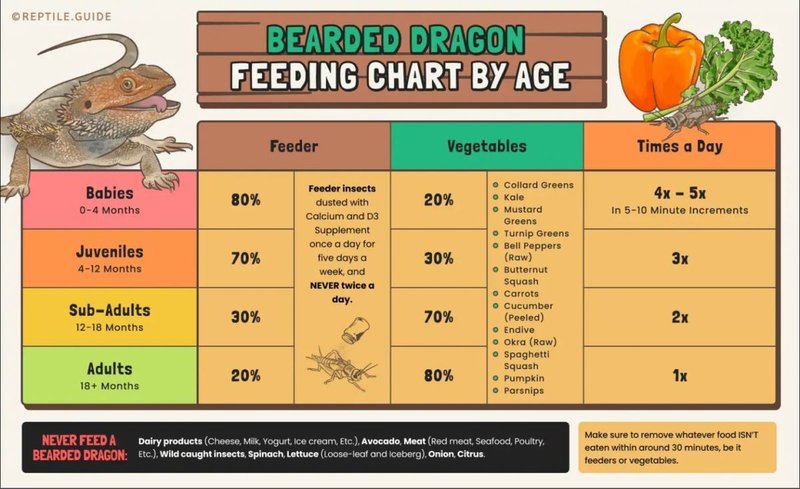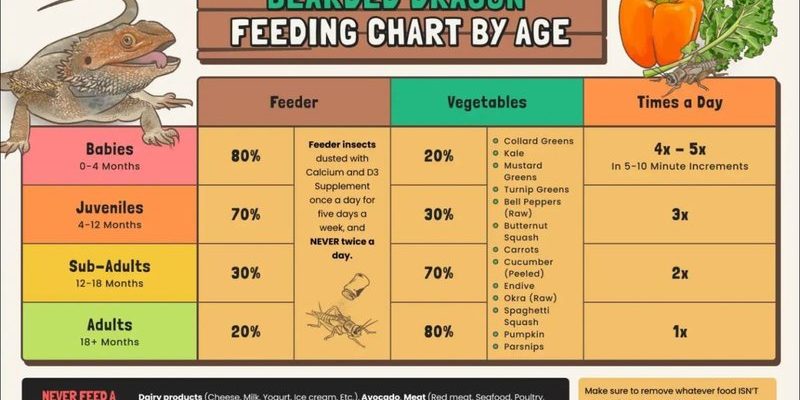
Let’s face it, bearded dragons aren’t picky eaters, but that doesn’t mean they can munch on anything at any time. They have specific nutritional needs that change as they grow. This article will walk you through the ins and outs of feeding your bearded buddy, so you can confidently keep their belly full and their spirits high.
Understanding the Bearded Dragon’s Diet
To understand how often to feed your bearded dragon, you first need to know what they should be eating. Bearded dragons are omnivores, which means they enjoy both insects and vegetables. Think of it like a well-balanced plate that includes a variety of foods: some crunchy crickets, leafy greens, and maybe even a few fruits for dessert.
For juvenile bearded dragons (those under six months old), protein is super important. They should eat mainly insects, like crickets and mealworms, making up about 80% of their diet. For adult dragons, that ratio flips. Once they hit around 18 months, the diet shifts more towards veggies, with insects only making up about 20-30% of what they eat. It’s like transitioning from a kid’s menu to a grown-up dinner, where they get to explore different flavors and textures.
To keep things simple, here’s a quick breakdown of their diet:
- Juveniles: Mostly insects (80%), with some greens.
- Adults: Mostly veggies (70%), with some insects (30%).
Feeding Frequency for Juvenile Bearded Dragons
If you’ve got a young bearded dragon, you’re in for a treat. Juveniles need to eat more often than adults, almost like they’re at an all-you-can-eat buffet. Generally, you should feed them 2-3 times a day. This frequent feeding helps them grow strong and healthy, and it mimics what they would experience in the wild.
When serving meals, keep portions small but satisfying. For instance, you might offer around 10-15 insects per session. If they’re still hungry, they’ll let you know by acting excited when you present more food. Just make sure to provide fresh salad every day, even if they nibble sparingly.
You might be wondering about the best time to feed them. A good rule of thumb is to feed them in the morning when they’re awake and ready to eat. This routine can also help you monitor how much they’re consuming.
Feeding Frequency for Adult Bearded Dragons
Adult bearded dragons have a different routine. As they mature, their metabolism slows down, and they don’t require as much food. For adults, feeding them every other day or about 3-5 times a week is generally sufficient.
It’s important to note that even though you’re feeding them less frequently, they still need a balanced diet. Make sure their meals consist primarily of greens, with a smaller portion of protein. A mix of leafy greens like collard greens, mustards, and even a bit of fruit can keep their diet interesting and nutritious.
Another tip is to always make sure they have access to fresh water. A shallow dish will work, but bearded dragons also often get their hydration from fresh veggies. Just don’t skip out on the water bowl!
How to Recognize a Healthy Eating Pattern
You might be wondering how to tell if your bearded dragon is eating enough. One of the key signs is their poop—yes, that’s right! Healthy digestion is a good indicator of proper nutrition. You want to see firm, dark brown droppings. If your dragon seems lethargic or isn’t pooping regularly, that could be a sign of over or underfeeding.
Another thing to watch for is their behavior during feeding time. If they’re eagerly jumping at their food, it’s a clear sign they’re hungry. If they start ignoring their meals or seem uninterested, it might indicate they’re either full or not feeling well. Always trust your instincts; you know your pet best!
Adjusting Diet Based on Season
Just like us, bearded dragons can exhibit changes in appetite based on various factors, including the season. During the warmer months, they typically eat more, while colder temperatures might lead them to munch less. You can adjust their feeding schedule accordingly. If they’re dormant in winter, you might want to scale back on food and monitor their energy levels.
Make sure you’re also considering their environment. If you notice they’re spending less time basking or seem sluggish, it might be time to check their habitat. A proper heat gradient in their enclosure can encourage them to eat more and feel more active.
Common Feeding Mistakes to Avoid
Even seasoned pet owners can make mistakes when it comes to their bearded dragon’s feeding. Here are a couple of common pitfalls to watch out for:
1. Overfeeding: It’s easy to think that giving them more food will make them healthier. However, this can lead to obesity and other health issues. Stick to the recommended feeding practices.
2. Neglecting Variety: Just like you wouldn’t want to eat the same meal every day, neither do bearded dragons. A varied diet is crucial for ensuring they get all the nutrients they need.
3. Skipping Supplements: If you’re feeding mostly insects, ensure you’re dusting them with a calcium and vitamin D3 powder. These supplements help in preventing metabolic bone disease, a common issue for bearded dragons.
4. Feeding Improperly Sized Insects: Make sure the insects are the right size—typically no larger than the space between their eyes. Bigger bugs can pose a choking hazard and stress your dragon.
Final Thoughts on Feeding Your Bearded Dragon
Feeding your bearded dragon isn’t just about filling their belly—it’s about ensuring they thrive. By understanding their unique nutritional needs and feeding them the right way, you’ll help your dragon grow happy and healthy. Remember to adjust for age, activity levels, and even seasonal changes.
Ultimately, every dragon is a little different, so keep an eye on their behavior and health. If you notice any changes, a vet visit can help you recalibrate their feeding routine. Enjoy every moment with your scaly friend—after all, feeding time can be a fun bonding experience!

